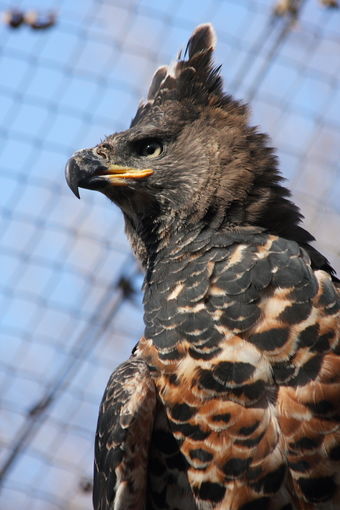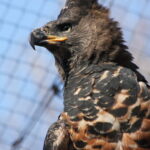Crowned eagles are known for their solitary and territorial behavior, living in pairs and building massive nests in the forks of large forest trees. These majestic birds are highly intelligent and cautious, with mature crowned eagles being nearly fearless towards humans and young eagles requiring an exceptionally long post-fledging period to learn hunting skills.
The Solitary Nature of Crowned Eagles
Crowned eagles are not known to fly in groups. These birds are highly territorial and prefer to live and hunt alone or in pairs. They are not social animals and do not form large flocks or groups like some other bird species.
Breeding and Nesting Habits
Crowned eagles typically breed once every two years, with the pair building a massive nest in the fork of a large forest tree. The nest can be up to 2 meters (6.5 feet) wide and 1 meter (3.3 feet) deep, and is used for multiple breeding seasons. The female lays a single egg, which both parents take turns incubating for around 42-45 days.
Hunting and Feeding Behavior
Crowned eagles are skilled hunters, using their powerful talons and sharp beaks to capture a variety of prey, including small to medium-sized mammals, birds, and reptiles. They typically hunt alone or in pairs, scanning the forest canopy from a high perch before swooping down to catch their prey.
Territorial Displays
Crowned eagles are highly vocal and have a noisy, undulating display flight that is often used both during the breeding season and outside it as a territorial display. During this display, the male performs steep dives and ascents, dropping as much as 60 meters (200 feet) at a time before circling back up, while the female may also perform independent display flights.
Factors Influencing the Solitary Behavior of Crowned Eagles
There are several factors that contribute to the solitary nature of crowned eagles:
Habitat and Prey Availability
Crowned eagles are found in dense, forested habitats, where prey may be scattered and resources are limited. By hunting and living alone or in pairs, they can more effectively defend their territory and secure enough food to sustain themselves and their offspring.
Breeding and Parental Care
Crowned eagles invest a significant amount of time and energy into breeding and raising their young. The long post-fledging period, during which the young eagles must learn essential hunting and survival skills, requires the undivided attention of the parents. This makes it difficult for them to form larger social groups.
Predator Avoidance
Crowned eagles are at the top of the food chain in their habitat, but they may still face threats from larger predators, such as leopards or humans. By living and hunting alone or in pairs, they can more effectively avoid detection and protect themselves and their offspring.
Conservation Efforts for Crowned Eagles
Crowned eagles are classified as “Least Concern” on the IUCN Red List, but their populations are still threatened by habitat loss, hunting, and human-wildlife conflict. Conservation efforts are focused on protecting their forest habitats, reducing illegal hunting, and promoting coexistence between humans and these majestic birds.
Habitat Protection
One of the key conservation strategies for crowned eagles is the protection and restoration of their forest habitats. This involves creating and enforcing protected areas, as well as working with local communities to promote sustainable land-use practices.
Anti-Poaching Measures
Illegal hunting and the wildlife trade pose a significant threat to crowned eagles. Conservation organizations are working to strengthen anti-poaching efforts, increase law enforcement, and raise awareness about the importance of these birds.
Community Engagement
Engaging local communities is crucial for the long-term conservation of crowned eagles. This involves educating people about the ecological importance of these birds, promoting coexistence, and finding ways for communities to benefit from the presence of crowned eagles in their local ecosystems.
Conclusion
In conclusion, crowned eagles are not known to fly in groups. These solitary and territorial birds prefer to live and hunt alone or in pairs, with their breeding and parental care responsibilities making it difficult for them to form larger social groups. Understanding the factors that contribute to their solitary behavior is essential for developing effective conservation strategies to protect these majestic birds and their forest habitats.


